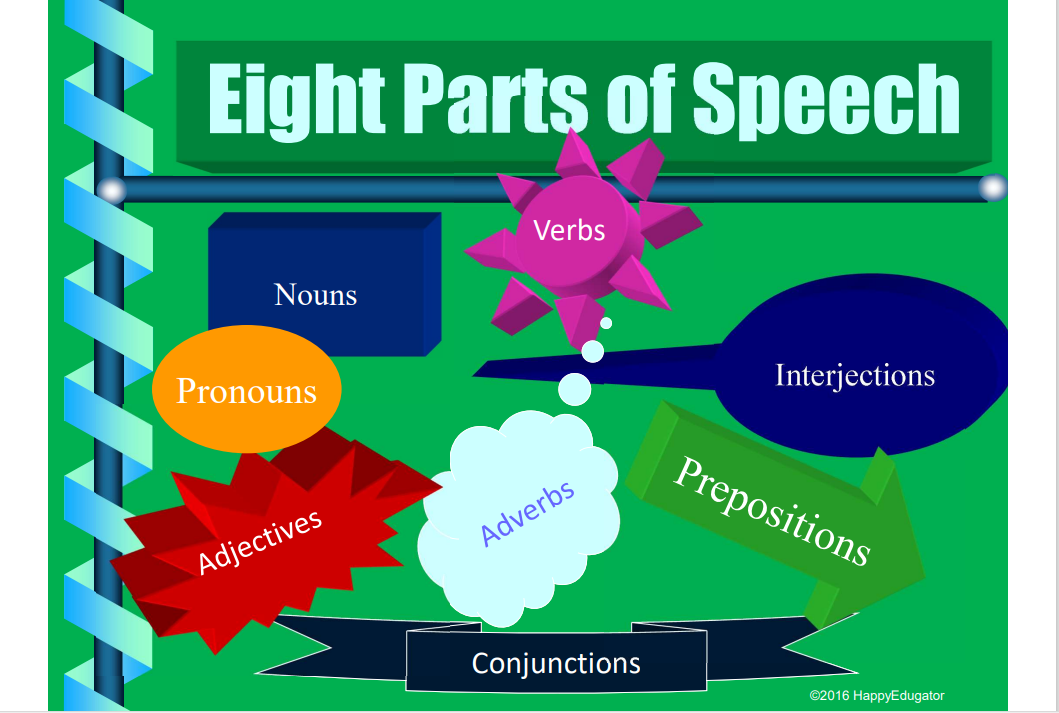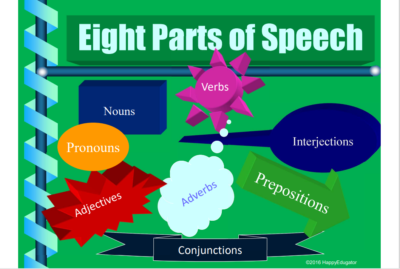
We use parts of speech in our spoken and written language daily, yet, many people have no idea what they are. What are the eight English parts of speech?
This lesson deals with that, We will define and examine each of them, which includes how and when each is used
Pay attention.
I will also explain why one of the eight parts could arguably be considered two separate parts and why I think it’s only one part.
Let’s get started. Shall we?
First Let’s Look At The Parts Of A Complete Sentence

Every complete sentence must have two main parts:
- Subject
- Predicate
Ironically, neither of these two parts are elements of what the title of this lesson is about.
However, by the end of this lesson, you will be able to see what makes a complete sentence more descriptive and informative.
You will also understand how the eight parts we’ll examine play their part(s) in the make up of a complete sentence.
What are the subject and predicate of a sentence?
Butte College defines them as follows:
SUBJECT
The subject of a sentence is the person, place, or thing that is performing the action of the sentence. The subject represents what or whom the sentence is about. The simple subject usually contains a noun or pronoun and can include modifying words, phrases, or clauses.
The man . . .
PREDICATE
The predicate expresses action or being within the sentence. The simple predicate contains the verb and can also contain modifying words, phrases, or clauses.
The man / builds a house.
 Introducing The Eight Parts
Introducing The Eight Parts
- Noun–A person, place, or thing
- Pronoun–Takes the place of a noun
- Adjective–Describes or modifies a noun or pronoun
- Verb–A word that shows action or a state of being
- Adverb–Modifies or qualifies a verb, adjective, or another adverb
- Preposition–Shows position or placement in relation to one noun or pronoun to another
- Conjunction–Joins or connects parts of a sentence
- Interjection–An exclamation that provides emotion to a sentence
Further explanation:
Nouns: I’ve heard it said that in addition to a person, place, or thing, that an idea is also a noun. That is true, but to keep it simple, an idea is a thing. Let’s not complicate it.
There are two main types of nouns:
- Common
- Proper
Some examples of common nouns are man, woman, city, state, country, building, car, and computer. Common nouns are generic in nature and are not capitalized.
Some examples of proper nouns are Jose, Mei, California, China, Westminster Abbey, Dodger Stadium, Chevrolet, Toshiba. Proper nouns are capitalized. They are specific names of persons, places, and things. Your name, the name of your country, and the brand name of your car or computer are examples of proper nouns.
Pronouns: Serve as simplified substitutes for nouns and take the place of nouns. For example, Jose, or any man is he or him; Mei or any woman is she or her; the pronoun that substitutes for a place or thing is it.
There are different kinds of pronouns.
Here are some examples:
- Personal/Subject pronouns–I, we, you, he, she, they, it
- Object pronouns–me, him, her, you, them, us
- Possessive pronouns–my, our, your, his, her, their, its
How and when they are used depends on several factors. We will cover that in another lesson.

Adjectives: Are words that modify or describe nouns and pronouns. There is also a special group of adjectives, called articles, which some call the ninth part of speech.
The most common articles:
- The
- A
- An
In any case, all adjectives do the same thing, as stated above, they modify or describe.
For example, a man, a big man, a pretty woman, a blue computer, an old car, The White House
Verbs: Show action or a state of being. There are several type but for now we will only talk about the two I just mentioned.
Some examples of action verbs: Do, make, go, drive, write, eat, sleep, like, think
A state of being shows no action.
Some examples: Be, am, is, are
All verbs have a present tense, past tense, and future tense. I have only given examples of verbs in the present tense. We will cover past and present tenses later.
Adverbs: Modify qualify verbs, adjectives, and other adverbs. They often end with the letters ly. They explain how, when, where, and to what extent something happened.
Some examples:
He will sleep soundly. Jose will drive moderately fast but carefully.
Prepositions: Show a relationship between one part of a sentence to another. They are part of a prepositional phrase, which begins with the preposition and ends with the object of the prepositon.
For example, She sits on the chair. The computer is next to the phone. The man walks through the door.

Imagine an airplane and a cloud in the sky. Think of all the different placements the cloud and airplane can have to one another. The relationships are prepositons/prepositional phrases
The plane can fly:
by the cloud, over the cloud, under the cloud, next to the cloud, through the cloud, inside the cloud, outside the cloud.
Conjunctions: Connect or join words and parts of sentences together, but there are others besides the words I highlighted.
Interjections: Are explanations or outburts that give a sentence emotion, although without them, the meaning of the sentence is the same.
For example, Oh my God, she just bought a brand new car! Yikes, Jack and Jill got married!
A Little More About Parts Of A Sentence

Usually, but not always, the subject of a sentence is a noun or pronoun.
It is who or what is doing the action or experiencing the state of being.
There are other parts of a sentence that are made up of different combinations of the eight parts we’ve covered in this lesson as well as other parts:
Object--Whereas the subject is who or what is doing the action, the object is who or what the action is to or for. Not all sentences have an object.
She eats the pizza. She is the subject, eats is the verb and pizza is the object. Do you know what word is an adjective/article?
Dependent clauses: Are phrases/parts of a sentence that are not complete sentences. They depend on another part of the sentence to make it complete.
Joe is a (is a dependent clause because it’s not a complete thought and it needs something to make it complete)
Independent clauses: Are complete sentences within a sentence
For example, Joe is a man and he is very important to many people. Although, this is one sentence, it is two complete sentences inside it.
What Is An Implied Subject?
It’s possible that a complete sentence can be one word. The word will always be a verb. The word/sentence is usually a direct command.
For example: Stop! Go! Eat! Study!
The implied subject in each case is whoever is being ordered or directed to do something. That could be you, me, us, or someone else.
Let’s Review

I hope I have answered the quesiton, “what are the eight English parts of speech?”, in a way that is somewhat simplified and understandable.
As usual in English, there is more to the story and of course, there are exceptions and variations.
However, once you understand the parts of a sentence the elements that make up sentences, it should help you to better understand the English language.
I will finish with a sentence that includes most of what I hope you learned in this lesson.
Whew! I diligently wrote this informative and expansive lesson for you, the students in this class.
Can you identify the parts.
Watch the YouTube video that corresponds with this lesson.
Practice the eight parts of speech
Have fun with the eight parts of speech.
Send me an email for the answers to the crossword puzzle.
Leave comments and questions in the box below. I will promptly respond.


A great English lesson on the eight parts of speech, I felt like I was back in school reading your article, in a good way of course. Being an English teacher I bet it must be frustrating when you see so many mistakes in people’s writing.
Reading this lesson actually reminds one of how sloppy they have become. I am pretty sure you can pull my comment apart, which is probably littered with mistakes (go gently though).
So I am going to stick around and read more of your lessons, thanks for the great resource.
Rob
Thanks for your comments Rob. I’m a Robert too but I go by Bob, although I’m English Teacher KBob. There’s a story behind the K.
Did you ever watch the Dick Van Dyke show? His name in the show is Rob Petrie.
Yes, I do get a bit frustrated with mistakes in writing but for the most part, I’ve learned to ignore it unless I’m dealing with students and a writing assignment. Although, I do spend a lot of time with my students peer reviewing and editing their writing.
I’m not going to pick your writing apart. In fact, I don’t see any mistakes.
Good job.
Feel free to comment or ask questions anytime.
This lays out things really nicely. I think it would be well worth the students to read this.
I have 2 schools in Vietnam and will be following you from now on.
I will check out your other posts as well.
Thanks
Steve Hey
Thanks for your comments Steve. That’s truly a compliment. I’m following you as well.
(K)Bob